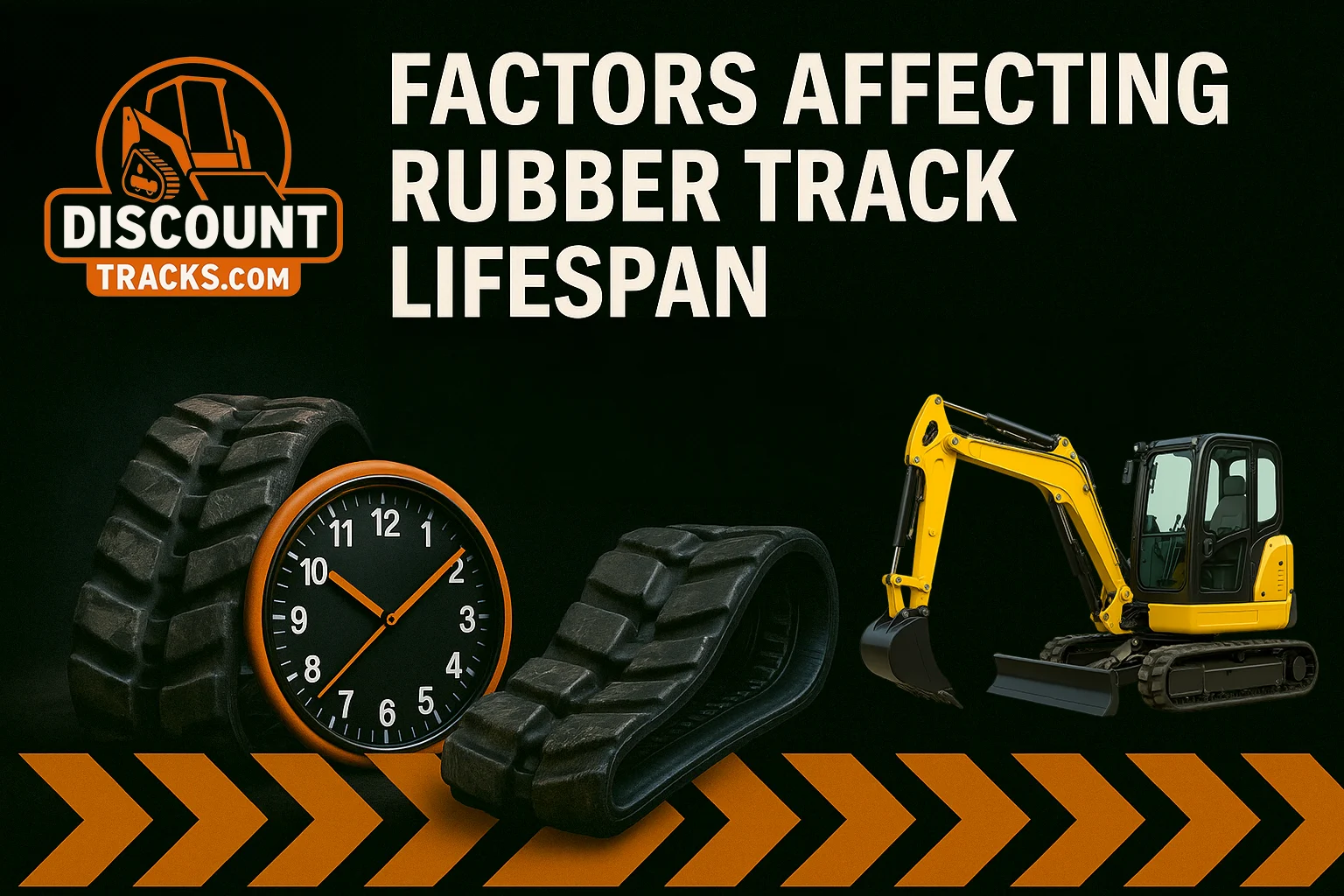Introduction
When you rely on rubber tracks to keep your machines moving, getting the most hours out of them isn’t just a nice bonus—it’s essential for your bottom line. Whether you’re running skid steers, compact track loaders (CTLs), or mini excavators, rubber track lifespan directly impacts your profitability, uptime, and productivity.
Unfortunately, rubber tracks don’t always last as long as expected. From premature cracking to uneven wear or outright failure, there are many factors that shorten rubber track durability—some preventable, some avoidable with smarter choices.
In this guide, we break down the key factors affecting track life and show you how to extend rubber track life through smart operation, proper maintenance, and—most importantly—how to choose durable rubber tracks that go the distance.
Why Maximizing Rubber Track Lifespan Matters
Frequent track replacements are more than just a budget line item—they cost time, productivity, and even customer satisfaction. Here’s what’s at stake:
- Replacement costs: Rubber tracks aren’t cheap, especially if you’re replacing them more often than you should.
- Downtime: Machines out of service during track swaps can delay jobs and contracts.
- Labor expenses: Whether in-house or outsourced, installing new tracks takes time and money.
- Undercarriage damage: Running worn tracks accelerates wear on sprockets, rollers, and idlers.
- Project delays: Equipment issues can push back timelines and cut into profits.
By understanding what shortens skid steer track life, mini excavator track life, and other CTL applications, you can take steps that lead to fewer replacements—and bigger savings.
Key Factors Influencing Rubber Track Lifespan
Multiple variables play a role in how long your rubber tracks last. Let’s break them down:
Operational Factors: How You Use Your Machine
Turning
Frequent counter-rotations or sharp pivots—especially on abrasive surfaces like concrete or rock—wear down the tread and edges quickly. Smooth, wide turns extend track life significantly.
Terrain
Working in demolition zones or over jagged rubble? Expect faster wear. Softer terrains like dirt or mud are much easier on rubber. Watch out for edge cuts when maneuvering around sharp debris.
Speed & Load
Running at high speeds or operating over the machine’s rated load can generate extra heat and pressure, reducing track life. Stay within manufacturer specs for best results.
Operator Skill
Seasoned operators who avoid sudden jerks, excessive spinning, and oversteering often see longer track life. Training matters.
Maintenance Matters: Proper Care Extends Life
Track Tension
Improper tension is one of the top contributors to premature failure. Over-tight tracks cause stress and faster wear, while loose ones increase the chance of de-tracking and uneven wear. Check tension regularly and adjust to manufacturer specs. Learn more about track tension.
Undercarriage Condition
Even brand-new tracks won’t last if paired with worn sprockets, idlers, or rollers. Regularly inspect your undercarriage and replace worn components to protect your investment.
Cleaning
Debris like rocks, mud, and ice build up around the undercarriage and cause abrasion and increased tension. Clean thoroughly and frequently, especially in muddy or harsh conditions.
Environmental Conditions
Sunlight, chemicals, and temperature extremes can break down rubber compounds over time. UV exposure leads to cracking, while oil or solvent spills accelerate degradation. Store equipment out of direct sun and away from chemicals when possible.
Inherent Track Quality & Construction (Choosing Durable Tracks)
Not all tracks are created equal. Even with perfect operation and maintenance, low-quality rubber or poor construction will shorten lifespan. The quality of materials and design play a foundational role in rubber track durability—and your decision when replacing tracks makes a difference.
How to Choose Rubber Tracks for Maximum Durability
The best way to extend your rubber track lifespan is to start with high-quality, well-matched tracks. Here’s how:
Look for Quality Construction Indicators
Durability begins at the material level. When shopping for long lasting rubber tracks, look for:
- Rubber Compound: Tracks made from virgin rubber blends with tear-resistant and UV-resistant additives last longer.
- Steel Cords: Continuous Steel Cord (CSC) technology provides superior tensile strength. Thicker cords with rust-resistant coatings prevent internal breakdown.
- Lugs & Embeds: Forged metal embeds with strong bonding resist separation and reduce failure under pressure.
Each of these features directly combats wear, tearing, and stretching, contributing to longer CTL track durability and consistent performance.
Match the Tread Pattern to Your Primary Application
Choosing the wrong tread for your environment causes excessive and uneven wear. Examples:
- Block Tread: Ideal for mixed-use and general construction.
- Staggered/Offset Tread: Great for traction on rough terrain.
- Turf-Friendly Tread: Designed to minimize ground damage on lawns and soft surfaces.
Using aggressive treads on pavement? You’ll burn through them in no time. Match the pattern to your jobsite.
Don’t Overlook the Warranty
A strong warranty reflects confidence in rubber track durability. Read the fine print—understand whether coverage is full or prorated, and what’s considered normal wear. A reputable supplier stands behind their product.
Focus on Long-Term Value (Cost-Per-Hour)
Don’t just look at the price tag—look at how many hours you’re getting. A slightly higher upfront cost often yields significantly better longevity, reducing your cost-per-hour and total replacement frequency.
Extending Your Tracks’ Life: Best Practices Summary
To maximize lifespan and get the most from your investment:
- ✅ Check and adjust track tension regularly.
- ✅ Inspect and replace worn undercarriage components.
- ✅ Clean tracks and undercarriage often, especially after heavy use.
- ✅ Operate smoothly—avoid sharp turns and high speeds on hard surfaces.
- ✅ Choose high-quality replacement rubber tracks built for durability.
- ✅ Match tread pattern to your most common jobsite conditions.
Partnering with Discount Tracks for Durable, High-Value Solutions
At Discount Tracks, we know that achieving a long rubber track lifespan starts with a quality product. That’s why we only supply tracks made with top-tier materials—premium rubber compounds, CSC-reinforced cores, and high-strength embeds—to deliver the rubber track durability professionals need.
We keep pricing competitive, so you get durable tracks without overspending—helping you reduce your cost-per-hour while keeping your fleet running smoothly. Whether you’re looking to prevent undercarriage wear, avoid premature failure, or simply get more hours out of your machine, we’re here to help you choose durable tracks that perform.
Conclusion
Your rubber track lifespan doesn’t just depend on how you operate—it starts with smart buying decisions and continues with regular care. By understanding the factors that cause wear and selecting long lasting rubber tracks built for the job, you can cut downtime and control your operating costs.
Ready to invest in tracks built for durability and value?
Explore Discount Tracks’ wide selection of quality replacement rubber tracks designed for longevity. Use our online tools or contact our knowledgeable team today to find the most durable solution for your machine and application.


